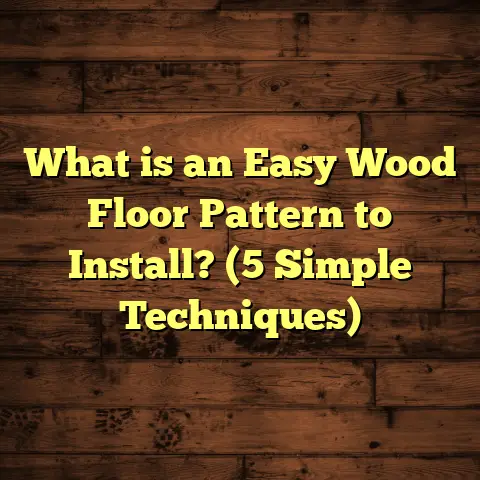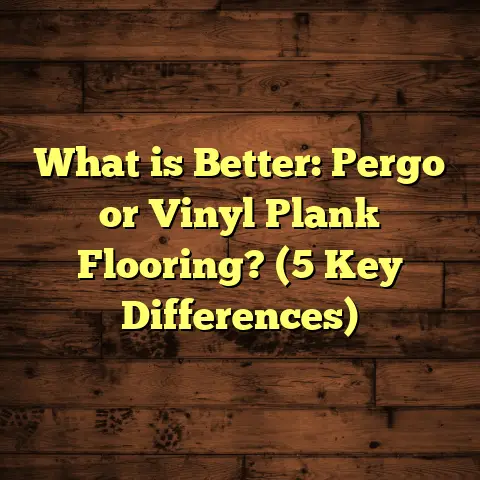What is SPC Flooring vs Laminate? (5 Key Differences Explained)
I always find it fascinating how much the right flooring can change a space—beyond just looks, it affects comfort, durability, and even how a room feels underfoot. When I first started working with different flooring types, I quickly realized that the hidden benefits often aren’t obvious until you live with them. Take SPC flooring and laminate, for example. They might look similar at a glance, but once you scratch the surface, you discover some key differences that could make or break your project.
Let me share what I’ve learned about these two popular flooring options—SPC (Stone Plastic Composite) flooring and laminate—and why understanding their unique qualities can save you time, money, and headaches.
What Is SPC Flooring and How Does It Compare to Laminate?
SPC flooring stands for Stone Plastic Composite. It’s a type of rigid core luxury vinyl flooring made by combining limestone powder (stone), polyvinyl chloride (plastic), and stabilizers. The result is a dense, durable plank that’s waterproof and highly resistant to dents and scratches.
Laminate flooring, on the other hand, is composed of multiple layers of fiberboard topped with a photographic applique layer that mimics wood or stone, sealed with a protective wear layer. While it’s known for affordability and ease of installation, it’s less water-resistant than SPC.
Both options are floating floors—meaning they don’t glue or nail down directly to the subfloor—but they handle moisture, wear, and aesthetics differently, which is critical depending on where you plan to install them.
Breaking Down SPC Flooring
SPC flooring is a relatively new product compared to laminate, but it’s gained popularity fast. The stone plastic composite core is what sets it apart from traditional vinyl planks or laminate. The limestone powder mixed with PVC creates an extremely dense and stable core layer. This means it doesn’t expand or contract much with temperature or humidity changes.
The top layers of SPC flooring include a high-definition image layer (which mimics wood grain or stone textures) and a wear layer that protects against scratches, stains, and fading. Many SPC products also have a UV coating to prevent discoloration over time.
Thickness-wise, most SPC planks fall between 4mm and 8mm thick. The wear layer varies from 0.3mm to 0.7mm depending on brand and price point. Thicker wear layers mean better protection in high-traffic areas.
Laminate Flooring’s Structure
Laminate has been around longer—decades in fact—and is known as a budget-friendly alternative to hardwood. It consists of several layers:
- A fiberboard core (HDF or MDF), which provides strength.
- A photographic layer that shows the wood or stone pattern.
- A clear wear layer for durability.
Laminate thickness usually ranges between 6mm to 12mm. The wear layer thickness varies too but generally sits between 0.2mm and 0.5mm.
Unlike SPC, laminate is made mostly from wood fibers compressed together. This makes it prone to water damage if exposed to moisture for too long.
1. Composition and Durability: What’s Under the Surface?
I remember one project in a coastal home where moisture was a constant concern. The homeowner was torn between SPC and laminate for their kitchen floors. Here’s what I explained:
- SPC Flooring:
- The core is made from limestone powder mixed with PVC, making it 100% waterproof.
- Thickness ranges typically from 4mm to 8mm, with wear layers from 0.3mm up to 0.7mm.
- This rigidity makes it highly dent-resistant.
- Because of its composition, it can handle heavy foot traffic and is less prone to warping in humid areas.
- Laminate Flooring:
- Its core is high-density fiberboard (HDF), which is vulnerable to water damage if exposed for long periods.
- Usually ranges from 6mm to 12mm thick, with wear layers around 0.2mm to 0.5mm.
- It’s sturdy but less resistant to dents compared to SPC.
- If water seeps into seams, swelling and warping can occur.
In that coastal kitchen, I recommended SPC for the wet environment because its waterproof properties were a game-changer. The homeowner later shared that after two years, the floor still looked flawless despite spills and humidity.
Why Thickness Matters More Than You Think
The thickness of flooring impacts not just durability but also comfort and sound absorption. For instance:
- Thicker SPC floors tend to feel more solid underfoot because of their dense core.
- Laminate floors that are thinner can sometimes feel hollow or more “clicky” when walked on.
For example, in one office renovation project covering 1,200 sq ft, we installed 7mm SPC planks with a heavy commercial-grade wear layer. The client noticed significantly less noise and better comfort compared to their old laminate floor.
Scratch Resistance: A Long-Term Perspective
SPC floors generally have higher scratch resistance due to their vinyl-based wear layer reinforced with ceramic beads in many cases. I’ve seen clients with pets who say their SPC floors look nearly new after years of scratching.
Laminate floors can resist scratches too but are more likely to show wear if not maintained properly.
2. Installation Methods: How Easy Is It to Lay Down?
Installation has always been something I’m passionate about because a good installation sets the tone for how the floor performs long-term.
- SPC Flooring Installation:
- Typically comes with a click-lock system.
- Because of its rigidity, it lays flat and is forgiving over minor subfloor imperfections.
- Can be installed over concrete, plywood, or even existing floors.
- Usually takes me about 3-5 hours for 300 sq ft, depending on room complexity.
- Laminate Flooring Installation:
- Also uses a click-lock or tongue-and-groove system.
- Slightly more flexible than SPC but requires a very flat subfloor to avoid issues.
- Installation time is similar, sometimes faster because laminates are lighter.
Subfloor Preparation Differences
One thing many people overlook is how much prep work each flooring type needs:
- SPC flooring’s rigid core means small bumps or cracks in the subfloor won’t telegraph through as easily.
- Laminate needs a perfectly smooth surface; even tiny imperfections can cause squeaks or damage over time.
In one commercial space renovation covering about 2,000 sq ft, we spent an extra day leveling some uneven concrete before laying laminate. If we had chosen SPC instead, we might have saved that time.
Tools & Techniques
Both types require similar tools: tapping block, pull bar, spacers, mallet, and saws for cuts.
However, because SPC planks are denser and heavier (each plank weighing around 5-6 pounds compared to laminate’s 3-4 pounds), installation can be more physically demanding.
3. Cost Considerations: What Will You Spend?
Budget always comes up early in conversations with clients. Here’s what I usually tell them based on recent market data:
- SPC Flooring Cost:
- Material prices range from $3 to $7 per sq ft.
- Installation generally runs between $2 and $4 per sq ft.
- Total project cost averages about $5 to $11 per sq ft.
- Laminate Flooring Cost:
- Materials usually cost $1.50 to $4 per sq ft.
- Installation costs are similar at around $2 to $3 per sq ft.
- Total comes out roughly between $3.50 and $7 per sq ft.
Hidden Costs You Might Not Expect
Sometimes clients forget about the extras needed:
- Underlayment for laminate (usually $0.30-$0.50 per sq ft).
- Transition strips for doorways or between rooms.
- Removal of old flooring (which can add $1-$3 per sq ft).
On one large-scale residential job spanning 1,500 sq ft, the homeowner was surprised when their initial budget didn’t include waste factor (we used about 7% extra for cuts and damage). Using FloorTally helped me give them an accurate final estimate including every detail—this tool’s ability to incorporate waste percentages based on room shape saved us both from unexpected expenses.
Regional Price Variations
Prices vary widely depending on location:
- In urban centers like New York City or San Francisco, expect labor rates on the higher end ($50-$75/hour).
- Rural areas may have labor rates closer to $30-$40/hour but fewer material options locally available.
Because I work primarily in the Northeast US, I often adjust estimates with local pricing trends in mind—keeping things realistic for my clients.
4. Appearance and Design Variety: Which One Looks Better?
When I pick flooring for my own projects or recommend products, aesthetics matter hugely. Both SPC and laminate come with a range of designs, but there are subtle differences:
- SPC Flooring:
- Often features realistic wood grain textures thanks to high-definition printing and embossing techniques.
- Some brands include hand-scraped or wire-brushed looks.
- Because SPC is vinyl-based, it can also mimic stone or ceramic tile finishes.
- Laminate Flooring:
- Wood pattern options are extensive, sometimes more authentic looking due to photographic layers.
- Can include textures but generally has a less “soft” feel underfoot compared to SPC’s vinyl surface.
I once installed an SPC floor in a modern condo where the client wanted a natural oak look with texture that didn’t feel “plastic.” The vinyl surface gave just enough realism plus comfort.
Texture & Feel Underfoot
People often ask me if these floors feel like real wood:
- SPC has a slightly softer feel because it has some give due to its composite core.
- Laminate feels harder since it’s fiberboard-based.
If you walk barefoot often or have kids playing on the floor, SPC can feel warmer and more comfortable.
Color & Finish Longevity
SPC floors usually hold color better over time due to UV coatings protecting against sunlight fading.
Laminate can fade slightly if exposed to direct sunlight continuously.
5. Maintenance and Longevity: How Long Will It Last?
Here’s where many people get surprised after living with their flooring for years.
- SPC Flooring Maintenance:
- Requires minimal effort—just sweeping and damp mopping.
- No sealing or waxing needed.
- Because it’s waterproof and scratch-resistant, it can last upwards of 20 years in residential settings.
- Laminate Flooring Maintenance:
- Needs regular cleaning but should avoid excess water.
- Over time, wear layers can dull; some brands last around 10-15 years depending on traffic.
From my experience working on both residential and commercial projects, SPC tends to hold up better under heavy use and moisture exposure. That said, laminate can still be a great choice for dry areas like bedrooms or living rooms where budget is tighter.
Stain Resistance & Cleaning Tips
I often tell clients:
- For SPC floors, you can use standard vinyl cleaners without worry.
- Laminate needs gentle cleaners specifically made for wood or laminate; harsh chemicals may damage the wear layer.
I once had a client spill red wine on their laminate floor; they managed to clean it quickly but admitted it was nerve-wracking since excessive scrubbing could dull the finish.
Real-Life Case Study: My Client’s Kitchen Makeover
A couple approached me wanting new flooring in their kitchen and dining area totaling about 400 sq ft. They were debating SPC vs laminate because they loved the look of laminate but wanted something durable for spills.
After running numbers through FloorTally including materials, labor, waste factor (about 6%), and local pricing, SPC came out at approximately $4,800 total, while laminate was closer to $3,200.
Given their lifestyle—two kids and pets—I recommended SPC because the waterproof guarantee outweighed the extra upfront cost for peace of mind.
Fast forward one year; they reported zero issues with stains or warping, unlike previous floors that needed frequent repairs.
Frequently Asked Questions About SPC vs Laminate
Can You Install SPC Flooring Over Radiant Heat?
Yes! One of the benefits of SPC flooring is its stability under temperature changes. I’ve installed SPC over radiant heating systems multiple times without issues related to expansion or contraction. Just be sure your heating system doesn’t exceed manufacturer temperature recommendations (usually around 85°F).
Laminate can also be installed over radiant heat but requires careful attention as some types may delaminate if exposed to high heat over time.
Which Flooring Is Better for Pets?
I get this question all the time from pet owners! SPC wins hands down here because it’s waterproof (no damage from accidents), scratch-resistant (from claws), and easy to clean.
Laminate floors are durable but can get scratched more easily by pets’ nails unless you go for premium scratch-resistant versions.
How Long Does Each Flooring Take to Install?
For an average-sized room (300-400 sq ft):
- SPC takes about 3-5 hours, depending on complexity.
- Laminate usually takes about 2-4 hours due to lighter planks and flexibility.
Keep in mind prep work like subfloor leveling can add extra time regardless of product choice.
What About Environmental Impact?
Both products use synthetic materials but differ widely:
- Laminate uses wood fiber cores sourced from recycled wood products often.
- SPC includes limestone powder but also PVC plastics; some brands offer recycling programs or low-VOC certifications.
If environmental concerns are top priority for you, it’s worth checking specific brand certifications before buying.
My Personal Insights From Working With Both Floors
After installing hundreds of thousands of square feet of both laminate and SPC over the years…
I’ll tell you this: I tend to lean toward recommending SPC for kitchens, bathrooms, basements—pretty much anywhere moisture could be an issue or durability is paramount.
But laminate still holds value:
- It’s a solid choice for bedrooms or living rooms where budget matters.
- If you want thicker planks that feel more substantial underfoot at an affordable price point.
Also worth noting: I’ve seen many DIYers successfully install both types thanks to straightforward click systems—with patience and proper tools you can save on labor costs too!
How FloorTally Helps Me Nail Flooring Costs Every Time
Estimating flooring costs accurately has always been a challenge—especially when juggling multiple quotes from suppliers, contractors, and factoring in waste percentages or regional cost differences.
That’s where FloorTally has been super helpful for me lately:
- It pulls local material prices automatically based on zip code.
- Lets me customize waste factor depending on plank size and room layout (I usually recommend between 5%-7%).
- Combines labor estimates based on local market data so my quotes are realistic—not just ballpark guesses.
- Shows breakdowns visually so clients understand where their money goes—materials vs labor vs extras like underlayment or transition strips.
Using FloorTally has saved me hours each week in estimating and improved client trust by giving them transparent numbers upfront.
Final Thoughts
Choosing between SPC flooring and laminate isn’t just about price or appearance—it’s about matching the right material to your lifestyle needs and installation environment. From my hands-on experience:
- If water exposure or heavy wear is likely, SPC is usually safer.
- For budget-friendly dry-area installs, laminate still holds strong.
- Tools like FloorTally have made my job easier by giving me quick yet detailed cost breakdowns tailored to each project.
Have you tried either of these floors before? What was your experience like? If you’re planning a project soon, feel free to ask me any questions—I’ve probably seen it all when it comes to floors!
If you want me to go deeper into any specific aspect like installation tips or cost breakdowns by region or case studies from certain climates/environments—just let me know!





